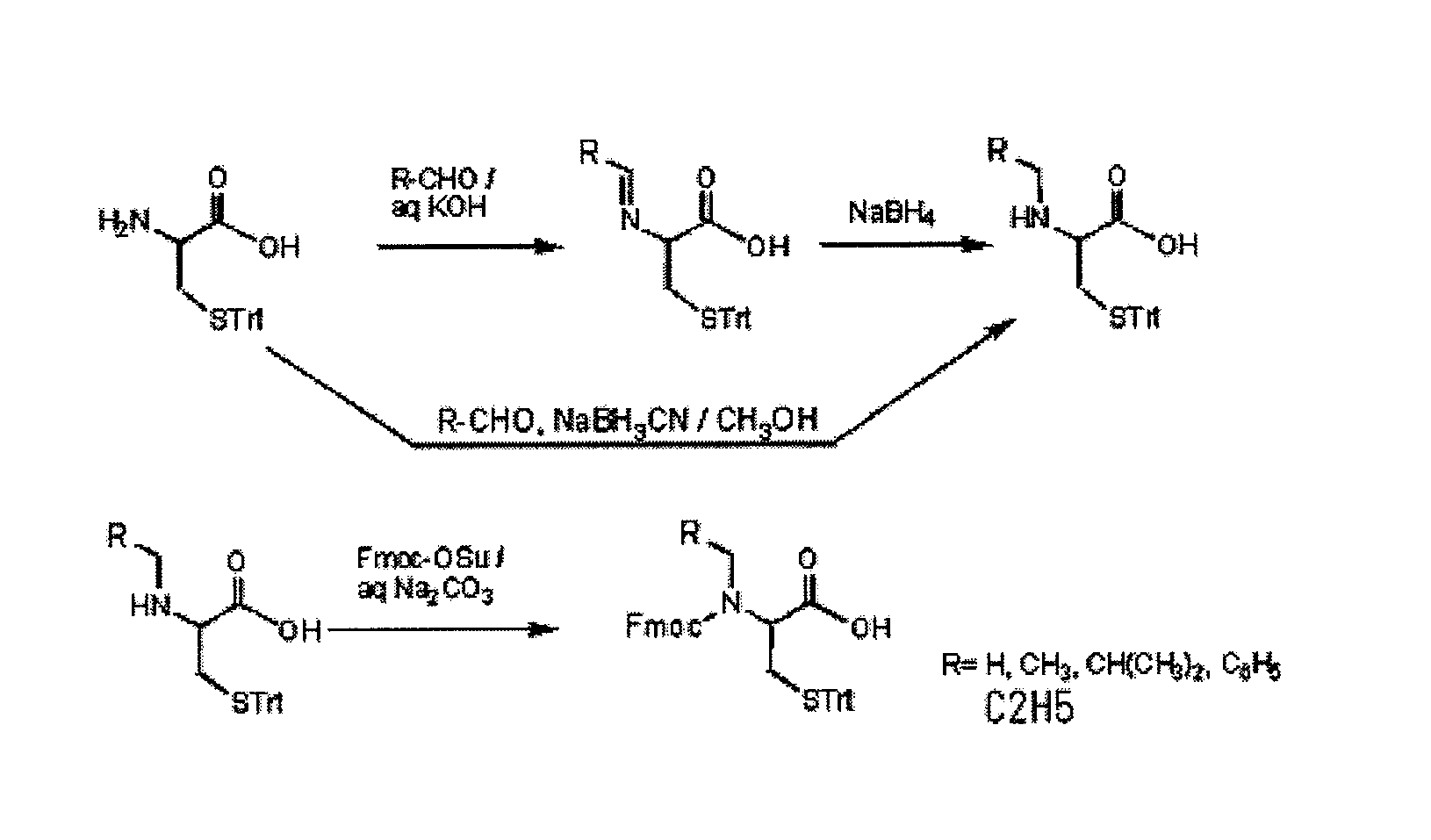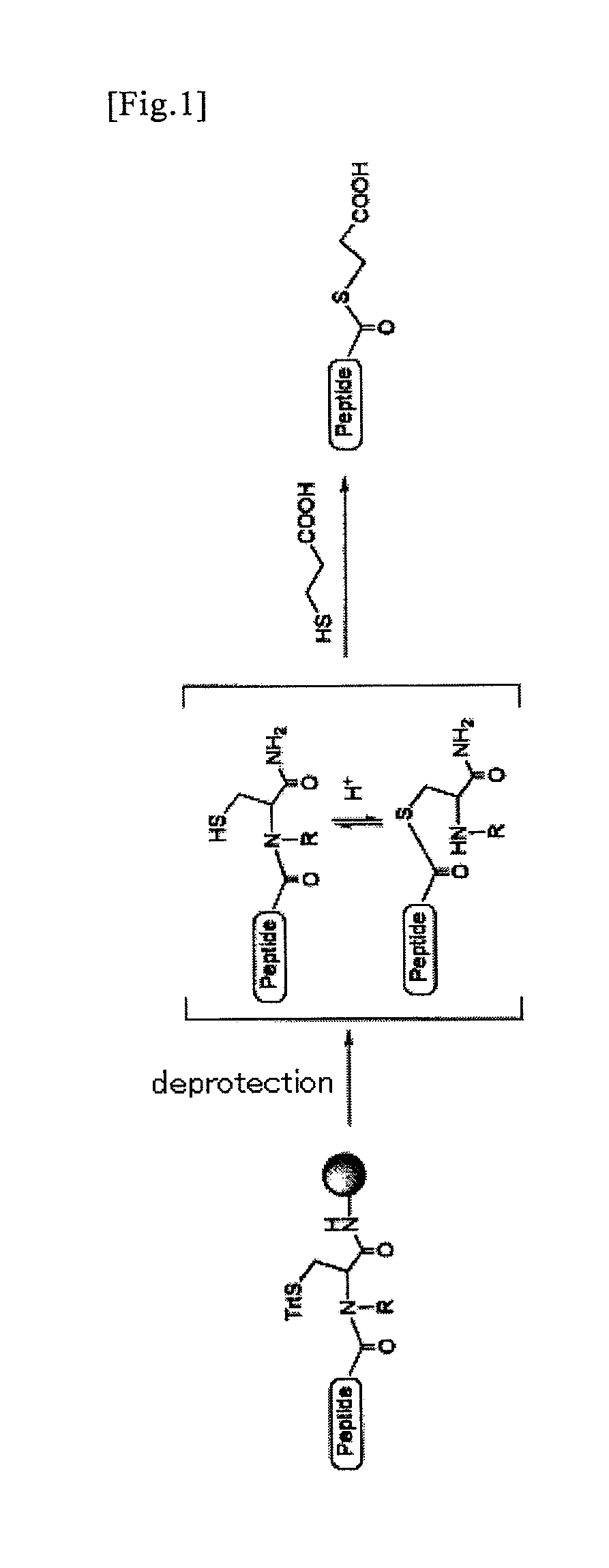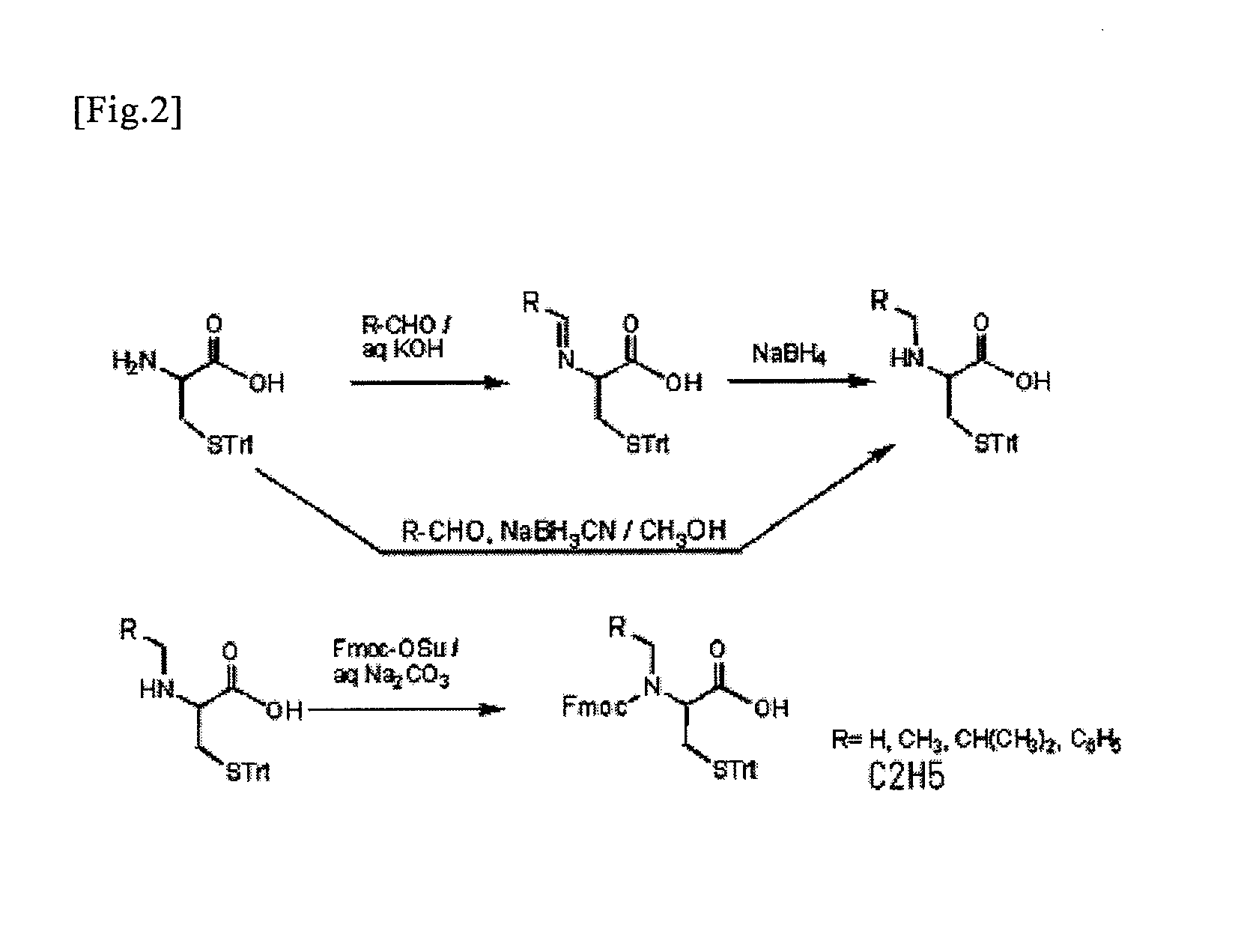Method for Producing Peptide Thioester
- Summary
- Abstract
- Description
- Claims
- Application Information
AI Technical Summary
Benefits of technology
Problems solved by technology
Method used
Image
Examples
example 1
(1): N-Ethyl-5-trityl-L-cysteine (1): Method using NaBH4 as a hydrogenating agent
[0048]S-Trityl-L-cysteine (1.0 g, 2.8 mmol) was dissolved in water (3.0 ml) containing ethanol (7.0 ml) and KOH (150 mg, 2.8 mmol). Acetaldehyde (0.20 ml, 3.6 mmol) was added to the solution. The solution was stirred for 1 hour at room temperature, NaBH4 (0.10 g, 2.8 mmol) dissolved in water (2.0 ml) containing 2 droplets of 1M NaOH was added, and then the solution was stirred at room temperature for 15 minutes and then at 60° C. for 10 minutes. After the temperature returned to room temperature, pH was adjusted at 4 using 1M HCl and then a target product was precipitated. After this, the precipitate was allowed to stand at 4° C. for 1 hour and then filtered. After washing with a small volume of distilled water, the resultant was dried at 50° C. under reduced pressure overnight. The thus obtained powders were purified by silica gel chromatography (chloroform:methanol=4: 1; containing of 1% acetic acid),...
example 2
N-(9-Fluorenylmethoxycarbonyl)-N-ethyl-5-trityl-L-cysteine
[0052]N-Ethyl-5-trityl-L-cysteine (220 mg, 0.56 mmol) was dissolved in a 10% sodium carbonate aqueous solution (3 ml) and 1,2-dimethoxyethane (1.5 ml). Fmoc-OSu (300 mg, 0.89 mmol) dissolved in 1,2-dimethoxyethane (1.5 ml) was added to the solution. The solution was stirred at room temperature overnight. After the precipitate was filtered, the filtrate was neutralized with 1 M HCl. A target product was extracted with ethyl acetate and then dried using anhydrous sodium sulfate. After the solvent was removed, the thus obtained residue was purified by silica gel chromatography (toluene: ethyl acetate=2: 1; containing of 1% acetic acid). Thus, the target product (280 mg, 0.46 mmol, 82%) was obtained.
[0053][α]D−39.6° (c 1.1 in CHCl3). Rf 0.31 (2:1 Toluene-ethyl acetate containing 1% AcOH).
[0054]1H-NMR (CDCl3): δ4.51-4.33 (m, 2H, Fmoc —CH2—), 4.19 (brt, J=6.6 Hz, 0.6H, Fmoc —CH—), 4.09 (m, 0.4H, Fmoc —CH—), 3.39 (m, 0.4H, —CH2CH3),...
example 3
N-Isobutyl-5-trityl-L-cysteine
[0055]S-Trityl-L-cysteine (1.0 g, 2.8 mmol) was dissolved in water (3.0 ml) containing ethanol (7.0 ml) and KOH (150 mg, 2.8 mmol) and then isobutyl aldehyde (0.30 ml, 3.3 mmol) was added. After the solution was stirred for 1 hour at room temperature, NaBH4 (0.13 g, 3.4 mmol) dissolved in water (2.0 ml) containing 2 droplets of 1M NaOH was added. The solution was stirred at room temperature for 15 minutes and then at 60° C. for 10 minutes. After the temperature returned to room temperature, pH was adjusted at 4 using 1M HCl, so as to precipitate a target product. After the precipitate was allowed to stand at 4° C. for 1 hour, the precipitate was filtered, washed with a small volume of distilled water, and then dried at 50° C. under reduced pressure overnight. The thus obtained powders were purified by silica gel chromatography (chloroform:methanol=7: 1; containing of 1% acetic acid), so that the target product (0.79 g, 1.9 mmol, 67%) was obtained.
[0056]...
PUM
| Property | Measurement | Unit |
|---|---|---|
| Time | aaaaa | aaaaa |
Abstract
Description
Claims
Application Information
 Login to View More
Login to View More - R&D
- Intellectual Property
- Life Sciences
- Materials
- Tech Scout
- Unparalleled Data Quality
- Higher Quality Content
- 60% Fewer Hallucinations
Browse by: Latest US Patents, China's latest patents, Technical Efficacy Thesaurus, Application Domain, Technology Topic, Popular Technical Reports.
© 2025 PatSnap. All rights reserved.Legal|Privacy policy|Modern Slavery Act Transparency Statement|Sitemap|About US| Contact US: help@patsnap.com



